How to Introduce a New Cat to Your Household: Steps for a Smooth Transition
Introducing a new cat to your household can be an exciting and rewarding experience for both you and your furry friend. However, it is important to approach the introduction process with patience and care to ensure a smooth transition.
Why Introducing a New Cat is Important
Introducing a new cat to your household is important for several reasons. Firstly, it can provide companionship for your existing cat or dog, reducing their stress and loneliness. Secondly, it can help your new cat to socialize and adapt to a new environment, making them feel safe and comfortable. Finally, it can enrich your own life by adding another loving pet to your family.
The Benefits of Introducing a New Cat to Your Household
Introducing a new cat to your household can have several benefits, including:
- Reducing stress and loneliness for existing pets
- Providing socialization and a sense of security for the new cat
- Adding another loving pet to your family
- Enriching your life and bringing joy to your household
However, introducing a new cat to your household can also be challenging, especially if your existing pets are not used to sharing their space with others. That’s why it’s important to follow some simple steps to ensure a smooth and successful transition.
Preparing for the New Arrival
Bringing a new cat into your household can be an exciting time, but it’s important to make sure you’re fully prepared to ensure a smooth transition. Here are some key steps to take to get ready for your new furry friend.
Choosing the Right Cat
Before you bring a new cat into your home, it’s important to choose the right one for your household. Consider the age, breed, and temperament that would be the best fit for your family and lifestyle. Think about whether you want a kitten or an adult cat, and whether you’d prefer a more independent or affectionate pet. It’s also important to consider any existing pets you have, as you’ll want to choose a cat that is likely to get along well with them.
Cat-Proofing Your Home
Cats are curious creatures, and it’s important to make sure your home is safe and secure before bringing a new cat into it. This means taking steps to cat-proof your home, such as securing windows and doors, removing any toxic plants, and keeping dangerous items like cleaning supplies and small objects out of reach. You may also want to invest in some cat-friendly furniture, scratching posts, and toys to help your new pet feel at home.
Preparing Your Other Pets for the New Arrival
If you already have pets in your household, it’s important to prepare them for the arrival of a new cat. This can be done by gradually introducing them to the scent of the new cat before the actual introduction. You can do this by swapping blankets or toys between the pets, or by using a pheromone spray to help calm any potential nerves. It’s also a good idea to set up separate areas for each pet, such as separate feeding and litter box stations, to help prevent any territorial conflicts.
| Things to Consider | Actions to Take |
|---|---|
| Choose the right cat for your household | Consider age, breed, temperament, and existing pets |
| Cat-proof your home | Secure windows and doors, remove toxic plants, and keep dangerous items out of reach |
| Prepare your other pets for the new arrival | Introduce them to the scent of the new cat before the actual introduction and set up separate areas for each pet |
By taking these steps to prepare for your new cat, you’ll be able to ensure a smooth and stress-free transition for both your new pet and your existing household members.

How to Introduce a New Cat to Your Household: Steps for a Smooth Transition
Introducing a new cat to your household can be an exciting time for both you and your furry friend. However, it can also be a stressful experience for your cats if not done correctly. To ensure a smooth transition, there are a few important steps you should follow.
Choosing the Right Time
Before bringing a new cat home, it is important to choose the right time. Make sure you have enough time to devote to the introduction process, as it can take several weeks for the cats to get used to each other. It is also best to avoid introducing a new cat during a time of major change, such as moving or remodeling your home, as this can cause added stress for all involved.
Creating a Safe Space
When bringing a new cat home, it is important to create a safe space for them. This should be a separate room where the new cat can stay for the first few days. This room should be equipped with all the essentials, including food, water, litter box, toys, and a cozy bed. By providing a safe space, your new cat can become familiar with their surroundings and feel comfortable in their new home.
Letting the Cats Meet
Once your new cat has settled in, it is time to introduce them to your other cats. This should be done slowly and carefully, allowing the cats to get used to each other’s scents before actually meeting face-to-face. You can do this by swapping blankets or toys between the cats’ spaces. When it is time for the cats to meet, do so in a neutral area, such as a hallway or a room they both have not been in before.
Supervising the Interactions
During the initial meetings, it is important to supervise the interactions between your cats closely. Keep a close eye on their body language and behavior, and be ready to intervene if necessary. If the cats seem to be getting along, you can gradually increase their time together. However, if there is any sign of aggression or tension, it is best to separate them and try again at a later time.
By following these important steps, you can help ensure a smooth transition for your new cat and your existing cats. With patience and care, your furry friends can learn to coexist happily in their new home.

After the Introduction
Introducing a new cat to your household can be a stressful experience for both you and your pets. However, by following the proper steps and taking the necessary precautions, you can ensure a smooth transition for everyone involved.
Monitoring Your Cats
After the initial introduction, it’s important to closely monitor your cats to ensure they are getting along and there are no signs of aggression or territorial behavior. Keep them separated for the first few days, allowing them to slowly get used to each other’s presence through a closed door or baby gate.
Once they seem comfortable with each other’s scent and presence, you can gradually increase their interactions under your supervision. If any signs of aggression or tension arise, separate them immediately and try again later.
Feeding and Playtime
During the introduction process, it’s important to feed your cats separately to prevent any conflicts over food. Provide each cat with their own food and water bowl in separate areas of the house.
Playtime is also a crucial part of the introduction process, as it allows your cats to bond and interact in a positive way. Provide them with toys and play together with both cats to encourage positive interactions.
Addressing Any Issues
If any issues arise during the introduction process, it’s important to address them promptly. Aggression or territorial behavior can be signs of stress or discomfort, and may require additional steps such as reintroducing your cats or seeking advice from a veterinarian or animal behaviorist.
Remember, introducing a new cat to your household can take time and patience. By monitoring your cats, providing separate feeding areas, and addressing any issues promptly, you can ensure a smooth transition for everyone involved.

Conclusion
Introducing a new cat to your household can be a daunting task, but with the right approach and patience, it can be a smooth and successful transition. Remember to take it slow and let your cats dictate the pace of the introduction process. Start with separate living spaces and gradually increase their time together until they are comfortable with each other.
It’s important to provide each cat with their own food, water, litter box, and toys to avoid any territorial disputes. Also, make sure to give them plenty of attention and love to alleviate any jealousy or resentment towards the new addition.
Keep in mind that each cat is unique and may require different methods for introduction. Don’t be afraid to seek advice from a veterinarian or animal behaviorist if you encounter any challenges.
With these steps and tips, you can help ensure a successful introduction and a happy household for all of your feline companions.
- Take it slow and let your cats dictate the pace of the introduction process
- Provide each cat with their own food, water, litter box, and toys to avoid territorial disputes
- Give them plenty of attention and love to alleviate any jealousy or resentment
- Seek advice from a veterinarian or animal behaviorist if you encounter any challenges
| Step | Summary |
|---|---|
| 1 | Separate living spaces |
| 2 | Gradually increase time together |
| 3 | Provide individual resources |
| 4 | Give attention and love |
| 5 | Seek professional advice if needed |
